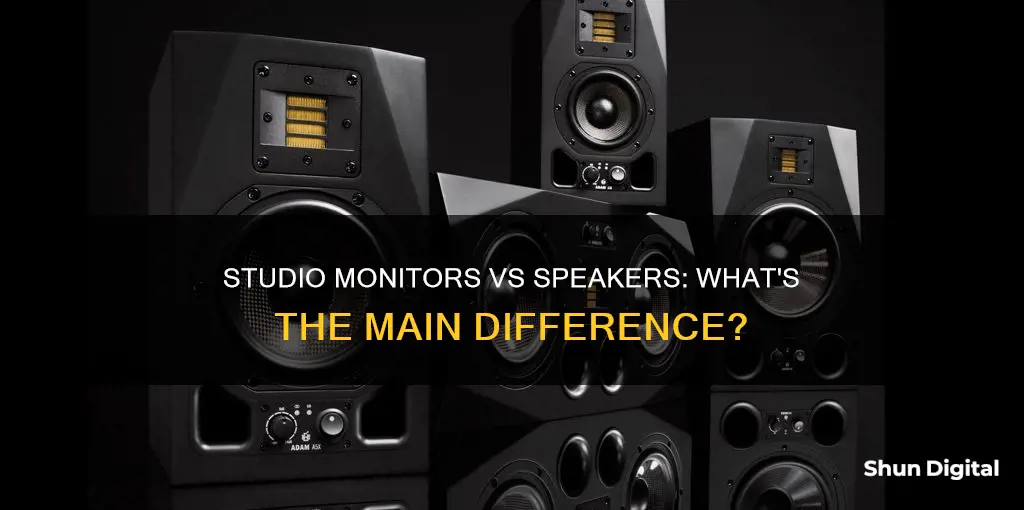
Studio monitors and speakers may look similar, but they are designed for different purposes and behave differently. Studio monitors are used for critical listening during the recording, mixing, and mastering processes, while speakers are designed for entertainment and enjoyment. Studio monitors aim for a flat, precise, and unaltered sound, allowing producers to identify and fix any sonic imperfections. In contrast, speakers often enhance audio levels by boosting bass or enriching tones in the mids and highs. Studio monitors are also more robustly built to handle high volumes and sudden sound bursts, while speakers may only need to reproduce compressed recordings. Additionally, studio monitors are typically placed closer to the listener to minimize sound reflections, whereas speakers are designed to blast sound throughout a room.
| Characteristics | Values |
|---|---|
| Purpose | Studio monitors are used for production, whereas regular speakers are used for consumption and enjoyment of audio products. |
| Sound | Studio monitors are designed to have a flat, precise, pure, and clean sound, without any emphasis or de-emphasis of particular frequencies. Regular speakers are designed to boost or enhance audio levels, such as by increasing bass or bringing out richer tones. |
| Use | Studio monitors are used for critical listening, allowing producers to identify and fix sonic imperfections. Regular speakers are used for casual listening. |
| Placement | Studio monitors are designed for near-field use, meaning they are placed a few feet away from the listener to provide a clear and immediate sound. Regular speakers are designed to blast sound throughout the room and are considered far-field. |
| Active/Passive | Studio monitors tend to be active, meaning they have built-in power amplifiers. Regular speakers are generally passive, receiving power from a dedicated standalone amplifier. |
| Individual Power Amplifiers | Studio monitors have multiple power amplifiers in one unit, allowing for individual power to the woofer, midrange, and tweeter. |
| Crossovers | Studio monitors have crossovers that split frequencies to ensure they go to the right driver, adding clarity and precision. |
| Circuit Boards | Studio monitors and regular speakers have different circuit boards built to handle different elements of audio production and consumption. |
| Amplification | Studio monitors may be active (including built-in amplifiers) or passive (requiring external amplifiers). Active models are usually bi-amplified, with separate amplifiers for low and high frequencies. |
| Physical Robustness | Studio monitors are built to be more physically robust than regular speakers to handle high volumes and sudden sound bursts in studio environments. |
What You'll Learn
- Studio monitors are designed for critical listening, whereas regular speakers are designed for casual listening
- Studio monitors are meant to sound bad so that imperfections can be identified and fixed
- Studio monitors are active speakers, while regular speakers are passive
- Studio monitors have multiple power amplifiers in one unit, resulting in a more precise sound
- Studio monitors are designed for near-field use, while regular speakers are designed for far-field use

Studio monitors are designed for critical listening, whereas regular speakers are designed for casual listening
Studio monitors and regular speakers may look similar, but they are designed for different purposes and behave differently. Studio monitors are designed for critical listening, whereas regular speakers are designed for casual listening.
Studio monitors are used in recording studios, filmmaking, television studios, radio studios, and home studios, where accurate audio reproduction is crucial. They are designed to produce a flat, linear phase and frequency response, meaning there is minimal emphasis or de-emphasis of particular frequencies. In other words, studio monitors provide an accurate, unaltered reproduction of the original audio. This makes them ideal for identifying and fixing any sonic imperfections in a recording. Studio monitors are also built to be physically robust to cope with high volumes and sudden sound bursts in studio settings.
On the other hand, regular speakers, also known as home stereo speakers or hi-fi speakers, are often designed to boost or enhance audio levels by upping the bass or bringing out richer tones in the mids and highs. They are meant to make music sound good and enjoyable in a variety of listening environments, such as at home or in a car. Regular speakers usually require external amplification, while studio monitors are typically self-amplified, with built-in power amplifiers.
In summary, studio monitors are designed for critical listening and accurate audio reproduction, making them essential tools for audio professionals during recording, mixing, and mastering processes. Regular speakers, on the other hand, are designed for casual listening and enhancing the listening experience, making them suitable for home entertainment systems and other consumer audio applications.
Monitoring Employee Internet Usage: Company Strategies and Tactics
You may want to see also

Studio monitors are meant to sound bad so that imperfections can be identified and fixed
Studio monitors are designed to sound "bad" in the sense that they do not enhance the sound at all. They are meant to have a flat, precise, and unadulterated sound for nearfield use. This means that they do not emphasise any one frequency, giving the user the most accurate impression of their mix so that they can easily identify and fix imperfections.
Studio monitors are designed for critical listening, which means that users can pick out sonic imperfections and fix them. This is in contrast to home stereo or hi-fi speakers, which are often designed to boost or enhance audio levels, such as by increasing the bass or bringing out richer tones in the mids and highs.
Studio monitors are also ""active" or "powered" speakers, meaning that they have built-in power amplifiers. This is in contrast to home speakers, which are typically ""passive" and require an external amplifier. Studio monitors are also more robustly built than home speakers as they have to cope with high volumes and sudden sound bursts.
Studio monitors are also designed to only project sound a short distance so that nothing in the room muddies up any frequencies. This is in contrast to home speakers, which are designed to blast sound throughout the room.
Monitoring Supplier Performance: Strategies for Effective Evaluation
You may want to see also

Studio monitors are active speakers, while regular speakers are passive
Studio monitors and regular speakers may look similar, but they are designed for different purposes and behave differently. Studio monitors are typically used in recording studios, filmmaking, television studios, radio studios, and home studios, where accurate audio reproduction is crucial. On the other hand, regular speakers are commonly used for home audio and entertainment systems.
One significant difference between studio monitors and regular speakers lies in their functionality. Studio monitors are designed to produce a flat, precise, and unaltered sound, meaning they do not enhance or distort the original audio signal. This flat frequency response ensures that all frequencies are reproduced accurately, without emphasising or de-emphasising particular frequencies. In contrast, regular speakers often boost or enhance audio levels by altering certain frequencies, such as increasing the bass or enriching the mid and high tones.
Another distinction between the two lies in their power source. Studio monitors are typically active speakers, meaning they have built-in power amplifiers, while regular speakers are usually passive and require an external power source, such as a dedicated standalone amplifier. This integration of the amplifier in studio monitors ensures optimal compatibility between the amplifier and speaker, reducing the likelihood of blowing out the speakers.
Additionally, studio monitors often have multiple power amplifiers in a single unit, allowing individual power amplification for different frequency ranges, such as woofer (bass), midrange, and tweeter (treble). This feature further enhances the precision and clarity of the sound produced by studio monitors.
The design of studio monitors also reflects their purpose. They are built to be physically robust to withstand high volumes and sudden sound bursts commonly encountered in studio environments. Studio monitors are also designed for near-field use, meaning they are intended to be placed close to the listener, minimising the impact of room acoustics and providing a clear and immediate sound. In contrast, regular speakers are typically designed to project sound across a room.
Monitoring Employee Performance: Strategies for Effective Tracking
You may want to see also

Studio monitors have multiple power amplifiers in one unit, resulting in a more precise sound
Studio monitors are designed to have multiple power amplifiers in one unit, resulting in a more precise sound. This means that the woofer (bass), midrange and tweeter (treble) cones are each powered individually. This is in contrast to home hi-fi speakers, which are generally passive, receiving power from a dedicated standalone amplifier.
Studio monitors are "active" speakers, meaning they have built-in amplifiers. This is different from home hi-fi speakers, which are typically "passive" and require an external power source. Studio monitors are designed to produce a flat frequency response, meaning they do not amplify or boost certain frequencies. Instead, they aim to reproduce the original sound as accurately as possible, without any colouration or distortion. This makes them ideal for critical listening and identifying sonic imperfections during the recording, mixing and mastering process.
The multiple power amplifiers in studio monitors allow for a more precise sound by ensuring that each frequency range is powered individually. This results in a clearer and more accurate reproduction of the original sound. Studio monitors are designed to be used in close proximity to the listener, typically within a few feet, to minimise the impact of room acoustics and provide a clear and immediate sound.
In summary, studio monitors with multiple power amplifiers in one unit offer a more precise and accurate sound reproduction compared to home hi-fi speakers. This makes them a valuable tool for audio professionals during recording, mixing and mastering processes.
Protective Monitor Wrap: Choosing the Right Size for Your Screen
You may want to see also

Studio monitors are designed for near-field use, while regular speakers are designed for far-field use
Studio monitors and regular speakers are designed for different purposes and have distinct characteristics. Studio monitors are designed for near-field use, typically placed on a stand or desk close to the listener, while regular speakers are designed for far-field use, projecting sound across a room.
Studio monitors aim to provide an accurate and unaltered reproduction of the source audio, making them ideal for critical listening and audio production applications. They are often used in recording studios, filmmaking, and broadcasting environments where precise sound reproduction is crucial. Studio monitors have a flat frequency response, meaning they do not amplify or boost certain frequencies like bass or treble. Instead, they deliver a pure and clean sound, allowing producers and engineers to identify and fix any sonic imperfections.
On the other hand, regular speakers, also known as home hi-fi speakers, are designed for entertainment and enjoyment. They are commonly used in home audio systems and are often designed to enhance the listening experience by boosting bass or enriching mid and high tones. Regular speakers are typically passive, requiring an external amplifier, while studio monitors are usually active, with built-in power amplifiers.
The physical design of studio monitors and regular speakers also differs. Studio monitors are built to be robust, as they need to handle high volumes and sudden sound bursts during audio production. Regular speakers, in contrast, often prioritise aesthetics and may be designed to blend in with home decor.
In summary, studio monitors are designed for near-field critical listening and audio production tasks, delivering an accurate and unaltered sound. Regular speakers, on the other hand, are designed for far-field use and focus on enhancing the listening experience for entertainment purposes.
Consequences of Defaulting on Ankle Monitor Payments
You may want to see also
Frequently asked questions
Studio monitors are designed to produce a flat frequency response, meaning they do not amplify or boost certain frequencies. This results in a pure, clean, and accurate sound, which is ideal for recording, mixing, and mastering processes. On the other hand, regular speakers often enhance audio levels by boosting bass or enriching tones in the mids and highs.
Studio monitors are designed for critical listening, allowing producers and engineers to identify and fix any sonic imperfections in a recording. They are built to be physically robust to handle high volumes and sudden sound bursts during playback. Regular speakers, on the other hand, are typically designed for enjoyment and may not provide an accurate representation of the original sound.
Studio monitors can be used for regular listening, but they are designed for near-field listening, meaning they sound best when placed a few feet away from the listener. They may not be ideal for a typical home listening setup, as the sound changes significantly when moving around the room. Regular speakers, or hi-fi speakers, are usually designed to sound good from any direction and in any space.







